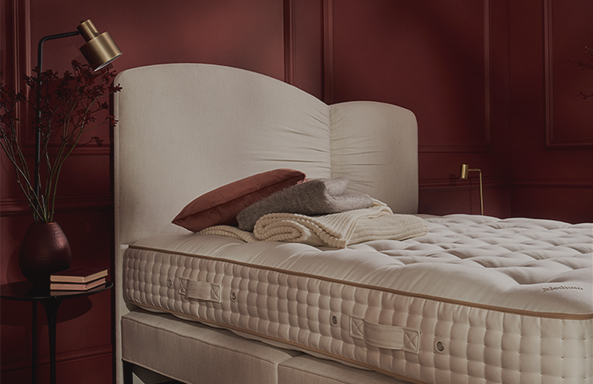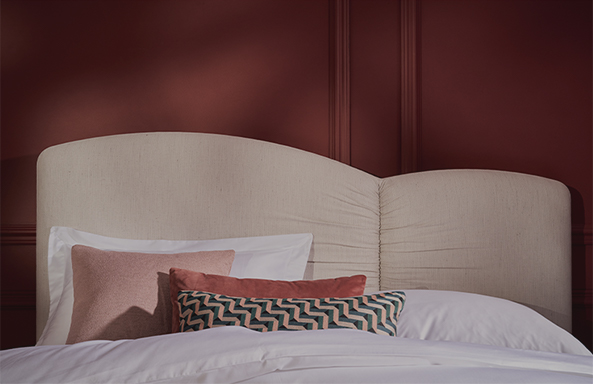Behind the Design: Kew with Designer Phoebe Leader
4 March 2022
We’re proud of our local community, and it is at the heart of our luxury sleep products, which is why we are delighted to launch our newest Vispring luxury headboard Kew. Designed by winner Phoebe Leader as part of an exclusive competition run in collaboration with Plymouth College of Art.
The Kew, chosen by a Vispring judging panel including designer and stylist Despina Curtis and founder and director of London-based PR agency, Tomorrow PR, Neil Byrne, and Vispring Managing Director Jim Gerety and Operations Director Chris Harrison. Phoebe’s design captures Vispring’s timeless aesthetic, with a modern twist and we’re delighted to be able to include it in our core range. With our factory based in Plymouth, supporting the progression of local design talent is important to Vispring; the collaboration with Plymouth College of Art has enabled the students to showcase their skills with fantastic results.
This week we sat down with Phoebe Leader to talk about all things design, inspiration and Phoebe’s process to designing Kew.
The Kew, chosen by a Vispring judging panel including designer and stylist Despina Curtis and founder and director of London-based PR agency, Tomorrow PR, Neil Byrne, and Vispring Managing Director Jim Gerety and Operations Director Chris Harrison. Phoebe’s design captures Vispring’s timeless aesthetic, with a modern twist and we’re delighted to be able to include it in our core range. With our factory based in Plymouth, supporting the progression of local design talent is important to Vispring; the collaboration with Plymouth College of Art has enabled the students to showcase their skills with fantastic results.
This week we sat down with Phoebe Leader to talk about all things design, inspiration and Phoebe’s process to designing Kew.
How would you describe your approach to design?
I like to fully understand the brief before I even begin designing; I ask myself questions such as ‘who are the target audience?’, ‘where will the product be used?’ And ‘how can I improve what already exists?’ The questions I ask myself prompt design responses, sometimes the answers are just sketches.
My approach to design is thorough – a no stone left unturned approach.
A lot of my work is inspired by nature, having grown up in the Wiltshire countryside I truly appreciate the impact of the natural world on health and wellbeing. I chose to write my dissertation on this subject as designing with nature in mind is one of my core values as a designer.
Using all of these aspects together (in-depth research, personal upbringing, and predicted trends) I was able to design something that encompassed all of these ideas in a stand-out product.
What would you say is your strongest skill and how have you honed that skill?
I have always loved drawing; where everyone at school loathed drawing from observation I jumped at the challenge of capturing something in front of me. My main topic of choice would be botanicals – trying to make my work look effortless like the subject is still something I am practicing! Practice really does make perfect, but I have found exercising the skills surrounding the skill in question beneficial. E.g. instead of trying to draw the same thing multiple times, try varying objects, mark-making, different media, setting time limits – the key is not to get bogged down with perfection, but to practice lots of related skills which will help you get towards your end goal.
“The key is not to get bogged down with perfection, but to practice lots of related skills which will help you get towards your end goal.”
What type of brief do you enjoy working on the most?
Being given a brief with a few particular requirements is my idea of heaven. It is a lot easier to rein in my research topics and start on something beneficial to the project, rather than presenting ideas that are cancelled straight away. This type of brief also lets me have my say on things too; perhaps the brief is to incorporate a specific colour scheme – it would then let me have freedom of choice over pattern, hardware, soft furnishing, finishes, etc. I enjoy trying to understand the client and what they will love but also combining my own preferences to create a flurry of interesting design ideas within their brief.
How would you describe the Kew headboard in 5 words?
Sophisticated, understated, informed, chic, and serene.
What was your main inspiration for the Kew headboard design?
My Vispring bed design started with an extensive browse of the website including downloading the brochures and reading through the history of the company. I noted down the things that stood out to me and used the existing collection as a basis for my work. Different avenues of research helped me to land on what I considered the strongest concept; Vispring’s proud use of quality fibres. From here, mohair became my fibre of choice with the Angora goat horns forming the main inspiration behind my design. The gentle sloping silhouette of each horn reminded me of rolling hills, the sea, birds flying… perfect connotations for relaxing and unwinding.
“The gentle sloping silhouette of each (angora) horn reminded me of rolling hills, the sea, birds flying… perfect connotations for relaxing and unwinding.”
What elements of Vispring’s history or product influenced your design?
The main sources of inspiration were the core fibres used in the luxurious mattresses. I found that of the fibres used, mohair was the most interesting to me. Other research was conducted but I kept coming back to this fibre which lead me to research it further.
I also found while researching the company it struck me that all of the existing designs are symmetrical down a centre vertical line. I found myself asking ‘why’ repeatedly – why are beds designed like this, why is this normal, why can’t I design something different? This then lead to bold decision-making and developing an asymmetric design.
What did you find most challenging when designing the Kew headboard?
I always find it challenging when it comes to narrowing down my ideas; my research is thorough so I often end up with more than one idea that I consider strong enough to develop. I find that creating a mind map of the pros and cons for each design helps me rule out designs that are simply that – good designs, but not practical ones.
Of course, entering a competition with two other coursework-based modules wasn’t easy either! Juggling time management in the design industry is a key skill that I encourage everyone to master – it is just as vital as being a good designer.
Which trends did you identify in the interior design landscape when working on this project?
Most noticeably I found asymmetry being mentioned on WGSN which worked seamlessly with my inspiration. I had noticed this key concept being used abundantly elsewhere as well- ceramics, fashion, graphics, architecture, landscaping, so I made the decision to use it in my bed design.
Neutral colours were also a big trend while designing the Kew – specifying an off-white fabric for the headboard made it versatile and meant that the stand-out feature was the contour along the top edge rather than the colour. The finished design features work in harmony, nothing is fighting for attention.
“The finished design features work in harmony, nothing is fighting for attention.”
And finally, what design top tip would you share with our readers?
Don’t rush your research! Take time to fully explore the different areas of your brief because your knowledge will show in your end product. Make sure to understand key areas such as your target audience and their core values before you begin any kind of designing.
You can shop the Kew headboard as well as explore our full headboard product range here.

